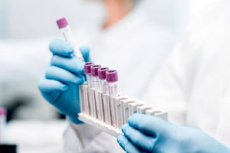New publications
Blood test may help predict risk of obstructive sleep apnea
Last reviewed: 02.07.2025

All iLive content is medically reviewed or fact checked to ensure as much factual accuracy as possible.
We have strict sourcing guidelines and only link to reputable media sites, academic research institutions and, whenever possible, medically peer reviewed studies. Note that the numbers in parentheses ([1], [2], etc.) are clickable links to these studies.
If you feel that any of our content is inaccurate, out-of-date, or otherwise questionable, please select it and press Ctrl + Enter.

Measuring levels of homocysteine, an amino acid, in the blood can help predict the risk of developing obstructive sleep apnea (OSA), a disorder characterized by periodic interruptions in breathing due to relaxation of the throat muscles during sleep. This simple blood test can also help doctors assess the likelihood that patients with mild or moderate OSA will progress to severe disease, according to a study in Brazil by researchers from the Sleep Institute and the Federal University of São Paulo (UNIFESP).
This study, published in the European Archives of Oto-Rhino-Laryngology, examined the relationship between homocysteine levels and the risk of developing OSA.
Professor Monica Levy Andersen of UNIFESP, the final author of the paper, notes: "We don't yet know whether sleep apnea causes increased homocysteine levels in the blood or vice versa. Our hypothesis is that it is a two-way correlation."
Vanessa Cavalcante-Silva, a postdoctoral fellow at UNIFESP and first author of the paper, explains: "A deficiency of B vitamins, especially B6, B9 and B12, predisposes to hyperhomocysteinemia. Consuming foods containing these vitamins or taking them as supplements may be a strategy to modulate blood amino acid levels."
The Episono sleep epidemiological study was initiated by Sergio Tufik of UNIFESP more than 15 years ago to study sleep quality and the impact of sleep disorders on the health of São Paulo residents. In 2007, the research team conducted a survey in which 42% of participants reported snoring three times a week or more, and nearly 33% had sleep apnea.
Andersen's team selected a sample of Episono volunteers who had undergone polysomnography to measure the apnea-hypopnea index (AHI). The researchers measured the AHI in 854 volunteers and found no apnea in 54.4%, mild apnea in 24.4%, moderate apnea in 12.4%, and severe apnea in 8.8%. Homocysteine levels in the blood were also measured, with levels up to 10 µmol/l considered normal, 10-15 µmol/l moderate, and more than 15 µmol/l high.
Cross-tabulation of the data showed that subjects with high homocysteine levels also had higher AHI. Those with homocysteine levels greater than 15 µmol/l had an AHI that was, on average, 7.43 higher than those with levels less than 10 µmol/l.
In a second phase of the study in 2015, the team found that a 1 µmol/L increase in homocysteine levels in 2007 was associated with a 0.98% increased risk of being diagnosed with sleep apnea in 2015.
The study found that high homocysteine levels are an important risk factor for OSA in non-smoking women. These findings highlight the need to promote smoke-free environments and raise public awareness of the health risks associated with second-hand smoke exposure.
